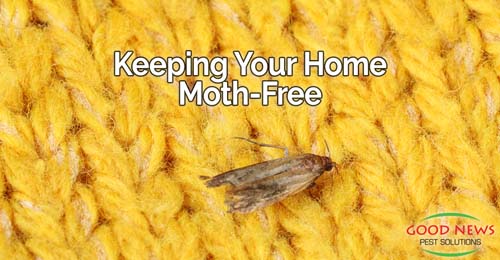
Keeping Your Home Moth-Free
There’s a popular belief that moths eat clothing – specifically, the wool in our sweaters. But that’s not entirely true.
It’s really no surprise why the mistake is so commonly made. After all, when we open the closet or attic, only to find clothes with bug holes in them, the first thing we may see is a moth flying out. But, too often we forget that moths are Lepidoptera and share the same life cycle as butterflies.
A Change Has Come
In reality, just like their more colorful cousins, clothes moths hatch as caterpillar-like larvae. It is the larvae that chow down on our wool, feathers, fur and leather. They’re actually seeking out a protein called Keratin, which also explains why the caterpillars don’t eat fully-synthetic fabrics and faux leather.
For refreshment, the larvae draw humidity out of the air, or suck residual moisture out of food and drink stains. They can also survive on any remaining perspiration.
Believe it or not, the larvae can stay in this stage for up to two and a half years! Once they have grown big enough, they start pupation, spinning themselves into a cocoon. In about 10 days, a newly metamorphosed clothes moth emerges. The males take flight in search of females to impregnate. Each female moth can lay 100-400 eggs, starting the process all over again.
Oh, and also, unlike what we typically think of as moth behavior, clothes moths aren’t attracted to light and will actually scurry deeper into darkness.
Cleaning the Other Closet
The other type of moths found in many homes are known as pantry moths. They are broken into two main categories: Indian meal moths or Mediterranean flour moths.
Just like the clothes moths, pantry moths lay about 400 eggs at a time. And they only lay them directly on the food source – grains or flours. In about a week, they hatch and the tiny caterpillars begin devouring the food source surrounding them. They are normally white or off white, although they take some color from the food source, so may have a brownish, pinkish, or greenish tint.
Over the next 6-8 weeks, the larvae will go through five stages of development, rendering the food they are living in completely unusable, so you throw out the contaminated food.
In most cases the caterpillars will spin their cocoons in or very close to the food. Occasionally, pantry moths will end up in linen closets, mistaken for clothes moths. It takes 15-20 days for them to emerge as a moth, and then they live for less than 2 weeks, mating and laying more eggs.
Pantry moths tend to flutter more than fly in a straight line. They are attracted to light, and may roam. They tend to be grey with a reddish brown or copper sheen on their wings.
And if you see one, you have an infestation.
Controlling the Chrysalises
Clothing moths can be controlled relatively well by regular cleaning, laundering, dry ice or all-natural red cedar moth balls. Most clothing moth infestations are a result of improper storage – sweaters and stored clothing should be brushed and cleaned periodically and placed in airtight containers.
Using a product that absorbs excess humidity can also help.
Pantry moths are a different story. Because they exist on your food, the food must be eliminated. Throw away any food you even suspect may be infested. To prevent pantry moths, keep everything in well-sealed containers. That includes dry dog and cat food, often overlooked.
Good News is capable of helping you with pantry pest issues and our Perimeter Plus Green Pest Control covers almost every other household insect or pest you might encounter in your home. And the risk-reduced treatments will eliminate your home’s insect access points that moths also use. If you’d like to schedule an appointment or discuss your pest control needs with one of our expert inspectors, just give us a call!
« Back to BlogProudly Serving
Sun City Center, Ruskin, Palmetto, Parrish, Ellenton, Bradenton, Anna Maria, Holmes Beach, Bradenton Beach, Longboat Key, Lakewood Ranch, University Park, Myakka City, Sarasota, Siesta Key, Osprey, Nokomis, Casey Key, Venice, Englewood, North Port, Port Charlotte, Punta Gorda, Arcadia
Things You Can Do
Pay Your Bill Online
Leave Us a Review
Request a Free* Termite Inspection
Stop Mosquito Bites
Get Rid of Rodents
Get a Termite Damage Warranty
Get Pest Control for Your Attic
Get Pest Control for Your Business Request Prayer
Corporate Address
1080 Enterprise Court, Ste A
North Venice, FL 34275
Call Now: (941) 412-9610
Text: (941) 412-9610
Fax: (941) 412-0080
